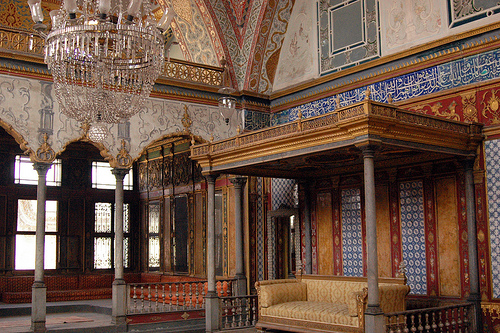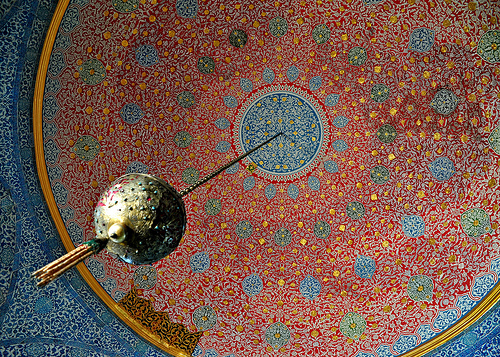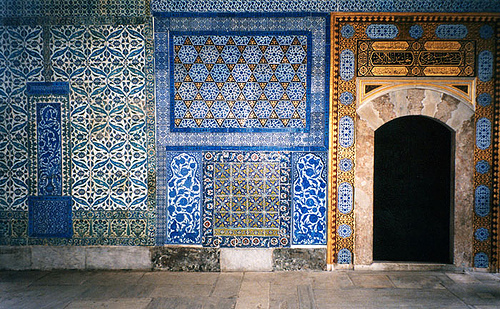Istanbul, first of all, is a historical city. Of course, the majority and most important period of its history is associated with the name Constantinople, but the current “Istanbul” has a story, too.
After Mehmet the Conquer invaded Constantinople, he suddenly found out that the palaces of Byzantine emperors were in ruins after the battle (what a surprise!), and, therefore, unsuitable for sultans, who needed luxury to survive. So, he started the construction of a new palace in 1453. They called it Topkapi Palace (“Topkapi” meaning “Gate of Cannons”).

The palace is accessed by the Imperial Gate, which leads to the Fountain of Sultan Ahmet III, whose reign period is known as the Tulip Era, because … well, the sultan really liked tulips.
After the fountain, you stand before the chain of 4 courts. The first court was open for the public or those who would come to the palace for any kind of business. The seclusion enhanced as you walked into the second court via the Middle Gate, built by Sultan Suleyman the Magnificent. At the time of Ottomans, no one except the sultan and his mother could enter the gate on a horseback.
The Council Chamber, the kitchen, and the provocative harem were all located in the second court. The harem was basically the sultan’s stock of concubines, who were all foreign and usually enslaved from different countries.
The sultan had the right to have up to four wives, which basically ruled the harem (after the almighty Valide Sultan, sultan’s mother). The Ottoman rulers could have as many concubines as they’d like. Say 100, 200 … 300! Unfortunately, only a dozen of rooms are currently open for tourists.

The third court was dedicated to the sultan and his private rooms. This court also includes the chamber for meeting the ambassadors and the big library of of Ahmet III.
Another interesting chamber in this court is the Dormitory of the Expeditionary Force. This is where you’ll witness a collection of gold thread, kaftans, uniforms, robes, and so on. But there is something even more interesting here. The Treasury!
The Treasury is housed in a building constructed by Mehmet the Conqueror. It has been the final stop for pieces of art captured from battles or precious pieces created by the masters living in the Ottoman Empire. There are precious stones from Russia, Britain, etc.
Finally, there is the fourth court, which was added only in the 19th century. This court contains some of the most secretive rooms of the sultans. One of them is the Circumcision Room, where boys were introduced to manhood.
In the 19th century, new and more luxurious palaces like Dolmabahce, became more popular for their Western designs, and the Ottoman sultans left the Topkapi Palace for a more European environment.
The palace was turned into a museum in 1924. Although this was the period when Turks allegedly became more modern, for some reason the Harem section was closed for visitors until 1960. No, there were no concubines there during the mentioned period … at least, there is no official mention about it.

While you can dive into the atmosphere and try to imagine what the rooms looked like when its residents paced through the rooms, there’s not much you can accomplish.
You’ll need 3-4 hours for a thorough tour, but it can be very crowded during the tourist season. The museum is open from 9:00 to 19:00 every day of the week except Tuesdays. To access the second court you’ll need to buy a ticket that costs $13. Another ticket costing $7 is needed to visit the Harem or you can just get the Istanbul Tourist Pass. If you want an audio guide, you can purchase it for another $7.
Get prepared for a day of pleasant torture. Make sure to wear super-comfortable shoes and light clothing. Bring along water and a snack (the palace cafe is horribly expensive).
This was a brief description of the greatest well-preserved Ottoman palace. It’s worth the visit, at least, for the sake of the famous story of Roxelana, a Russian concubine, who conquered the greatest man of the Ottoman Empire, the Sultan. A simple girl, who won the sultan, won the palace, and won the empire lived in Topkapi and definitely deserves a few hours of your journey.


